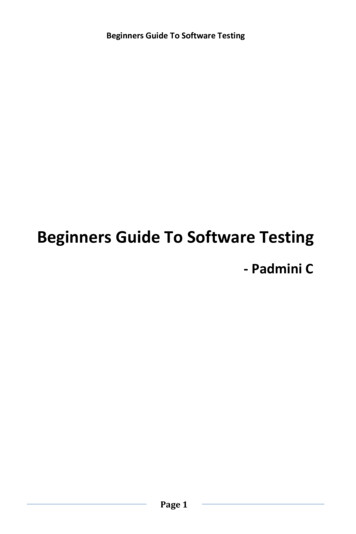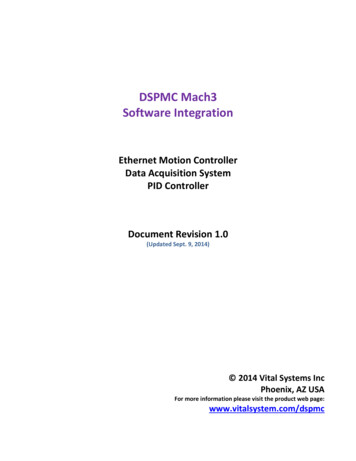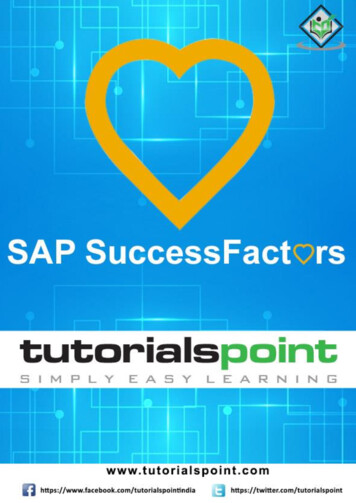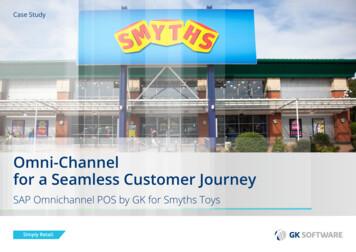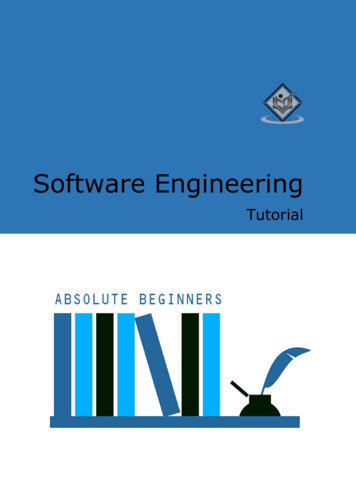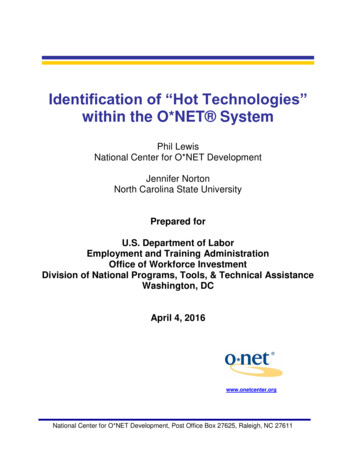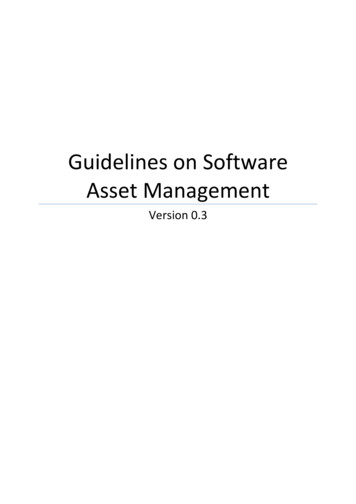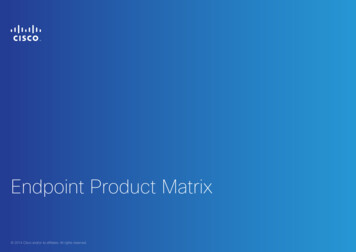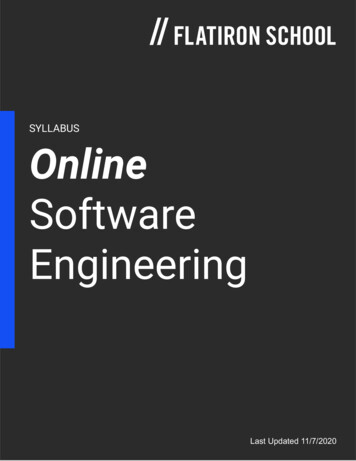
Transcription
SYLLABUStOnlineSoftwareEngineeringLast Updated 11/7/2020
Table of Contents345679101112132OverviewThe Power of Learning Ruby and JavaScriptCurriculum OverviewFull Stack Web DevelopmentThe Full Stack Journey: An In-Depth LookWhat Makes a Software Engineer?How We LearnProgram Pace and ScheduleJobs OutcomesContact Us
OverviewFLATIRON SCHOOL’S SOFTWARE ENGINEERING IMMERSIVEBeing a software engineer requires more than knowing how to code or build a web app. During the time spentwith Flatiron School’s online community, students learn to think, and build, like software engineers. In eachcurriculum module, students develop key skills through interactive labs, lectures, and close collaboration,showcasing progress through Portfolio Projects. While the bulk of the material covered occurs within the Rubyand JavaScript ecosystems, we carefully design our curriculum to prepare students to launch softwareengineering careers, independent of any specific language or technology.By undertaking this rigorous but rewarding program, students: develop a foundation in programming fundamentals conquer the concepts of Object-Oriented Programming work with APIs (Application Programming Interfaces) become proficient in database modeling and ORM (Object Relational Mapping) understand MVC (Model-View-Controller), a pattern used by frameworks like Rails to build large-scaleapplications execute application deploymentBy the completion of the program, students have done much more than simply build technical skills: they havemaintained technical blogs to show they can credibly talk tech; they have become a part of the tech community;and they have established a portfolio of personally-relevant, functional web applications to show employers asthey enter the job-search phase with the support of our Career Services team.Proven ResultsFlatiron School students get jobs — period. In our most recent Online Outcomes Report, 94% of students werehired. As a graduate of our Online Software Engineering course, job-seek with the support of our CareerServices team. From weekly 1:1 career coaching sessions, to mock interviews, to employer evangelism, ourseasoned Career Services team is dedicated to helping our students launch lifelong careers within 6 months ofgraduation, or we’ll refund your tuition (see eligibility terms).Download the full details of our 2018 Online Outcomes Report at https://flatironschool.com/outcomes/See our eligibility terms at ment/3
The power of learningRuby and JavaScriptWHY DO WE TEACH THESE LANGUAGES TO ASPIRING DEVELOPERS?ReadabilityOpen SourceProgramming is about abstractions andexpressions: the mechanics of code are universaland exist in all modern languages. Much of theinitial difficulty in learning programming stems fromthe learning curve necessary to gain comfort with alanguage’s syntax.Both Ruby and JavaScript have nurtured vibrant,supportive open source communities—there areover 900 Ruby groups on Meetup.com, totaling over500,000 members worldwide; JavaScript has over4,000 groups on Meetup.com with over two millionmembers. Ruby also has a huge and usefulecosystem of over 60,000 libraries. This will allowyou to leverage free, publicly-available tools to buildapplications with complexity and real-world usebeyond what you could approach otherwise.Ruby was specifically designed for readability. Rubyreads remarkably like English, allowing newprogrammers to focus immediately on thefundamental concepts and logic, rather thanconfusing syntax. As such, even beginners canstart building right away. We find Ruby to beextremely effective at helping students learn how tothink like programmers: break problems down,express themselves technically, abstract ideas, andwork together with other programmers.JavaScript is the language of web browsers:everyone browsing the web can have theirexperience changed and defined by a developerwho knows JavaScript. Recently, JavaScript hasbegun to have an even larger presence outside ofthe browser thanks to NodeJS. It’s fast becoming“everyone’s second language”.Both Ruby and JavaScript have the advantage ofbeing interpreted languages versus compiled likeC and Java. The added overhead of compilationmakes seeing fast feedback harder. Ruby andJavaScript let you see your results fast—making itsimple to start building and learning.Career FlexibilityLearning to code and evolving as a programmer is alifelong endeavor. No matter what language onelearns first, all programmers have to learn otherlanguages throughout their career in order to keeppace with changing technology. Starting off yourcoding education by learning both Ruby andJavaScript not only makes you a moreversatile—and employable—programmerimmediately; it prepares you for the essential taskof continuing to learn throughout your career asnew languages, frameworks, and technologiesappear.
Curriculum OverviewGETTING STARTEDBefore starting our Software Engineering Immersive, students must complete an initial technical assessmentfocused on their choice of JavaScript or Ruby—this will require some prior programming experience. In order toprepare, we recommend beginning to work on our free Introduction to JavaScript, Introduction to Ruby, orCoding Bootcamp Prep courses, which can be accessed at FlatironSchool.com. If accepted into the program,students will prepare for the first 14 days of the program, a busy and critical time. During the first 14 days,students will be required to complete various requirements to continue in their cohort.MASTERY-BASED PROGRESSOur program is broken into five curriculum modules. Each module concludes with a comprehensive projectmeant to bring together students’ competencies and demonstrate them in their portfolios. Students work inteams and directly with instructors to ensure they’ve mastered key concepts before progressing. If studentsneed additional support, they receive additional direct mentorship, and, if necessary, they’ll have the opportunityto repeat a module at no extra cost.LIFELONG LEARNINGGraduates join an active network of successful software engineers. For Flatiron alumni, engaging with ourcommunity doesn’t stop at graduation—and nor do opportunities to learn. Students enjoy lifetime access to ourCareer Services team and extensive employer network as they approach future career changes.5
CURRICULUM OVERVIEWFull Stack Web DevelopmentWe designed our Full Stack Web Development Curriculum to give studentsthe necessary expertise in both back-end and front-end programmingtechnologies to become full-stack developers. It's a more extensive courseof study than the average school offers – but then we expect more of ourstudents.Module 1: Programming FundamentalsAfter diving into the fundamentals of programming, students get comfortable with object-oriented programming and storingdatabases using SQL and Object Relational Mappers.Module 2: Web FrameworksStudents learn two key Ruby frameworks, first mastering the fundamentals of web programming with Sinatra beforeexperiencing how quickly they can build incredible apps with Rails.Module 3: JavaScriptStudents gain a thorough understanding of Javascript – crucial for front-end developers.Module 4: Front-end FrameworksStudents learn to build productive, scalable front-ends with React and Redux, creating slick, functional, reactive code withRedux as a state manager and Rails as the back-end JSON API.Solo ProjectsAfter completing four curriculum modules focused on group projects, students work with instructors to come up with soloproject concepts and spend dedicated time building truly sophisticated applications on their own. Students receive plentyof instructor feedback along the way while diving deep into various advanced technologies needed to bring their conceptsto life.6
CURRICULUM OVERVIEWThe Full Stack Journey: An In-Depth LookFlatiron School’s Full Stack Web Development Curriculum is at the heart of ourSoftware Engineering Immersive. Below, we take a closer look at the exactlanguages students learn in modules 1-4.RubyStudents learn fundamental concepts in programmingincluding repls, methods, loops, variables, variablescope, conditionals, blocks and iterators, casestatements, arrays, scope, hashes, regular expressions,iterators, enumerables, data structures, nesting, andmore. Topics build in complexity and provide thefoundation for the rest of the course.We help students embrace error messages as cluesand gain a fundamental appreciation for failure as theonly way to learn and progress. Students gainexperience in debugging with various gems and toolsdesigned to track down issues in code.HTML & CSSStudents master the basic building blocks of how theweb is rendered and become fluent in the language thatmakes the web beautiful. They additionally learn how toconceive of and build UIs for web apps by writingwell-structured HTML and CSS , as well as using SASSto create efficient and organized front-ends.GitStudents begin exploring version control using gitcommands including with cloning, branching, merging,rolling back commits, forking, and submitting pullrequests.Object Relational Mapping & SQLORM (Object Relational Mapping) allows programmersto query and manipulate data from a database using anobject-oriented paradigm. Students learn to write andmanipulate data using the Ruby language.They gain an appreciation for the structure of adatabase, how to map out tables, and the differencebetween the various table relationships. Students learnhow to wireframe database structures, as well as howto link their applications to a database. They also coverSQL, domain modeling, relational database theory,schema architecture, and the Object Relational Model,including the ActiveRecord pattern.RackObject OrientationStudents gain experience with Object-OrientedProgramming and understand how it allowsprogrammers to bundle code and create reusableobjects and methods, which allows for increasingcomplexity in software.7This unit is designed to give students an understandingof HTTP and how the Internet works, as implementedthrough the Ruby web interface of Rack. Students buildtheir own HTTP servers and learn how the request /response model of the web works. Their servers listento HTTP requests and respond with well-formed HTMLresponses. Students learn to understand the web withthe few abstractions provided by the tool set.
THE FULL STACK JOURNEY: AN IN-DEPTH LOOK ContinuedSinatraReactSinatra is a Domain Specific Language (DSL) written inRuby for building web applications on top of Rack. Thisframework provides students with exposure to designpatterns in web applications. The topics covered in thisunit include architectural patterns such as REST(Representational State Transfer), MVC(Model-View-Controller), HTML Forms, ERB (EmbeddedRuby) and template rendering, and applicationenvironments.Using plain JavaScript with large web applicationsquickly becomes unruly. Initially created by Facebook,React is the premier JavaScript framework for buildingfast web user interfaces. This unit starts with thefundamentals of components. Students learn how tobuild the basics of React before they are taught how touse React itself. After building a minimal React,students conquer the complexities of React and thenquickly move into learning about state managementwith Redux. After completing this unit, your applicationswill effortlessly consume APIs, render data quickly, andscale as application complexity increases.RailsWith a foundation in the Ruby language as well as thearchitecture of the World Wide Web, students utilizeRails to build complex, functional web applicationsfrom the ground up. They learn the file structure ofRails, how to set up their own databases, how to drawroutes and create Rails forms, gain an understanding ofthe asset pipeline, and bring it together by integratingfront-end design skills.Students also have the ability to take on moreadvanced concepts such as authorization, validation,and callbacks. Once they grasp the basic functionalityof Rails, they spend time building out their own Railsapplications, moving through the entire process fromideation to execution.JavaScriptJavaScript powers the user experience of the web.Students learn the basics of JavaScript syntax, itsfunctional architecture, and different approaches to theobject model. Students then learn the Document ObjectModel (DOM) Javascript API provided by the browser todynamically interact with HTML. Students use native“vanilla” JavaScript (versus a library). Students thenexplore the popular Javascript frameworks React andRedux.8
What makesa SoftwareEngineer?While the linear progression of our curriculum isfocused on building technical skills, our aim is toteach students how to become softwareengineers—which is distinct from simply knowinghow to code. Students engage in a number ofactivities that hone their communication andcollaboration skills and immerse themselves in thetechnical community, helping build the foundationneeded to grow as software engineers in thefuture.PORTFOLIO PROJECTSAt the conclusion of each program module, students build advanced Portfolio Projects to demonstrate boththe technical skills they’ve gained in the module and their creativity. Previous projects have won prestigioustech awards, become MVPs for startups, and been presented at the White House. Portfolio Projects representan opportunity for students to explore specific technologies that interest them while building a portfolio of fullyfunctional web applications to impress employers.ACTIVE GITHUB PROFILEGitHub is the modern software engineer’s resume. Students push every line of code they write at FlatironSchool to GitHub through our learning platform, Canvas giving them an extensive profile to show employersand fellow engineers.ROBUST BLOGAll Flatiron students maintain technical blogs to show they can not only write code, but also communicate howthat code works – an essential skill for software engineers.TECHNICAL PRESENT
07.11.2020 · Open Source Both Ruby and JavaScript have nurtured vibrant, supportive open source communities—there are over 900 Ruby groups on Meetup.com, totaling over 500,000 members worldwide; JavaScript has over 4,000 groups on Meetup.com with over two million members. Ruby also has a huge and useful ecosystem of over 60,000 libraries. This will allow
